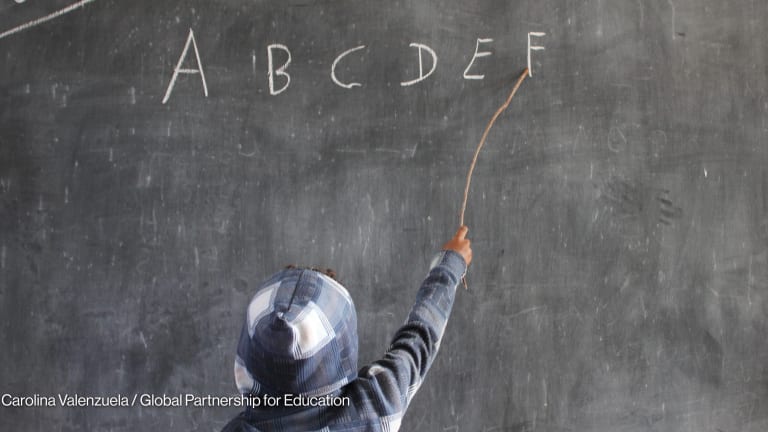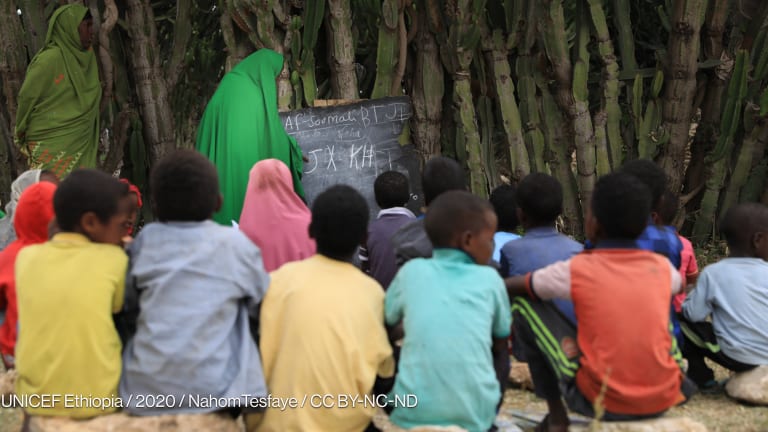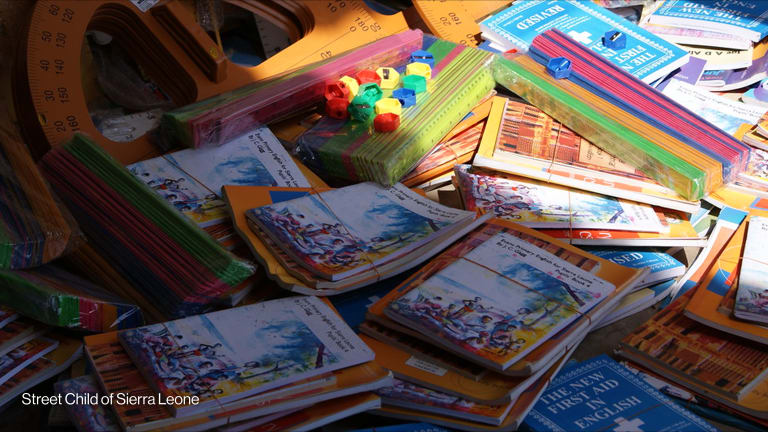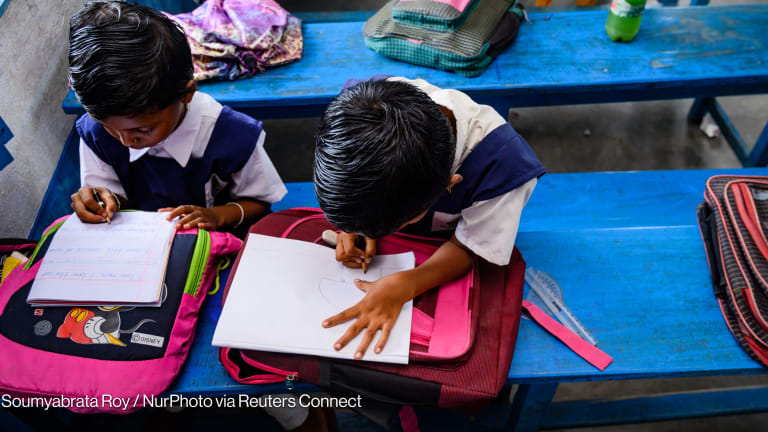The EU, a rising champion of education in emergencies?
Despite being the center of intensifying global debate, education in emergencies is still in sore need of a champion — a role the European Union could well fill in the near future, should it play its cards right.
Five years after the adoption of a groundbreaking resolution by the U.N. General Assembly, global action on education in emergencies is still in sore need of a champion — a role that the European Union could well fill in the near future. Speaking at the Oslo Summit on Education for Development earlier this month, European Commissioner for Humanitarian Aid and Crisis Management Christos Stylianides announced his plan to dedicate 4 percent of the EU humanitarian aid budget to education for children in emergency situations over the course of his mandate. The announcement comes as a breath of fresh air for many nongovernmental organizations. As funding for education in emergencies continues to be sidelined in favor of more traditional, lifesaving humanitarian responses, their hope is that the EU’s decision will have a catalytic effect on mobilizing other donors. “Education in emergencies is notoriously difficult to secure funding for,” David Skinner, director for education at Save the Children, told Devex. “As a standard setter on humanitarian response, the EU’s decision to increase the financing available for education in emergencies … raises the bar for what is acceptable or not in terms of donor financing for education in emergencies.” But a herculean task awaits the EU. As of today, 28.5 million children living in conflict and crisis-affected areas are denied their right to education. Yet, education in crisis receives less than 2 percent of total humanitarian aid, making it the most chronically underfunded of all humanitarian sectors. A solid start Education in emergencies is rarely the focus of donor strategies and policies. In fact, only a handful of donors have official documents outlining principles, goals and areas of focus related to the sector — and the EU is one of them. While education in emergencies is not enunciated as one of the EU’s official humanitarian priorities, the EU’s humanitarian arm — commonly designated as ECHO — has laid the groundwork for more decisive action in the field. This is notably the case through the publication, in 2008, of a policy paper and two supporting working documents focused on helping children in need. Recent years have also witnessed the EU institutionalize its financial support for education in emergencies. Launched in 2012 and specifically dedicated to children’s education in conflict-affected regions, the EU “Children of Peace” initiative is currently active in 19 countries across the globe. And the program is growing in size. From the initial 2 million euros ($2.2 million) allocated in 2012, funding for the initiative was doubled in 2013, before reaching 6.7 million euros in 2014. This year, the budget is expected to hit a new record of 11 million euros — of which 1 million euros will be dedicated to children affected by the Ebola epidemic in West Africa. While such an upward trend is commendable and encouraging, the commission’s objective to provide, by 2019, an average 40 million euros per year to education in emergencies will require unprecedented and concerted efforts from EU institutions and member states. “The first priority for [the EU] would be to ensure that they ‘walk the talk’ and actually manage to allocate 4 percent of their humanitarian funding to education in emergencies,” Silje Skeie, education adviser at the Norwegian Refugee Council, said. Demand for education in emergencies is strong. The results of a survey conducted in Ethiopia and the Democratic Republic of the Congo highlight that displaced persons tend to rank education ahead of all other basic services. “When we ask people affected by wars and conflicts what they themselves would prioritize, they often put education first. Education is not only essential to give children hope and possibilities for the future, but can also create a sense of normalcy in a tough situation, and provide protection,” Skeie noted. Rather than competing with other sectors, evidence suggests that schools are a vector of support for other humanitarian sectors — including food, health and protection. “Education is an entry point for many other sectors,” Skinner said. “[Through it] we can increase the number of and level to which we have holistic programs that are integrated across a range of themes.” Areas of challenge and promise In light of the limited interest that has so far characterized education in emergencies, the potential for the EU to become a game changer is significant. But beyond funding, what should the EU focus its efforts on? For one, education requires a long-term perspective, which humanitarian aid alone can’t provide. Yet the issue of education in emergencies is not addressed at all in the EU’s Agenda for Change — the bloc’s overseas aid policy. This points to the urgent need for ECHO and EuropeAid — the EU’s development cooperation authority — to enhance collaboration in an effort to bridge the humanitarian-development gap, both in terms of policies and funding. “It is fundamental to start all education in emergencies operations using developmental lenses,” Minna Peltola, education expert at Finn Church Aid, said. “No one is educating their children only for three months, six months or one year — which is often the maximum [duration] for humanitarian aid funding.” Meanwhile, consensus is growing over the EU’s power to change the discourse surrounding education in emergencies. Official figures indicate that between 2012 and 2014, approximately 263,000 children have benefited from the EU “Children of Peace” scheme. But numbers are not all that matter. “Our experience with ECHO grants is that the EU, like other donors, is grappling with the question of quality versus access [when it comes to education in emergencies],” Laura Vanhanen, education adviser at Finn Church Aid, told Devex. “But the EU is in the position to take leadership on this position and shift the discourse and actions from the singular focus on access to a broader focus on both quality and access.” As the EU seeks to achieve greater reach and impact in the near future, there are a number of areas in which it can demonstrate much-needed stewardship. “[The EU could] shape innovations in education in emergencies by designing and testing solutions for complex and unpopular problems such as financing schemes for teachers, delivering teacher training for teachers, and providing environmentally sustainable and flexible learning environments,” Mary Tangelder, regional education specialist for East and Southern Africa at Finn Church Aid, stressed. Strategic, systemic changes that go beyond specific, country-level projects would also be welcome. “[The EU could provide] dedicated funding to build the capacity and capability of education in emergency experts,” Save the Children’s Skinner told Devex. According to him, this would enable responders on the ground to understand what approaches work best, while boosting their ability to secure more funding for education — ultimately contributing to the emergence of a well-rounded system for the provision of education in crisis or fragile contexts. The opportunities to drive education up the world’s agenda are numerous. As the world’s largest humanitarian donor, the EU just has to seize them — and strive to set the tone at negotiations for the creation of a global humanitarian fund for education in emergencies. “EU engagement in the discussions around a global platform for education in emergencies will help us develop the right solution to meet the education in emergencies challenge, secure significantly more funding for education in emergencies and, finally, provide children with what they want most in times of crisis — an education,” Skinner concluded. Check out more insights and analysis for global development leaders like you, and sign up as an Executive Member to receive the information you need for your organization to thrive.
Five years after the adoption of a groundbreaking resolution by the U.N. General Assembly, global action on education in emergencies is still in sore need of a champion — a role that the European Union could well fill in the near future.
Speaking at the Oslo Summit on Education for Development earlier this month, European Commissioner for Humanitarian Aid and Crisis Management Christos Stylianides announced his plan to dedicate 4 percent of the EU humanitarian aid budget to education for children in emergency situations over the course of his mandate.
The announcement comes as a breath of fresh air for many nongovernmental organizations. As funding for education in emergencies continues to be sidelined in favor of more traditional, lifesaving humanitarian responses, their hope is that the EU’s decision will have a catalytic effect on mobilizing other donors.
This story is forDevex Promembers
Unlock this story now with a 15-day free trial of Devex Pro.
With a Devex Pro subscription you'll get access to deeper analysis and exclusive insights from our reporters and analysts.
Start my free trialRequest a group subscription Printing articles to share with others is a breach of our terms and conditions and copyright policy. Please use the sharing options on the left side of the article. Devex Pro members may share up to 10 articles per month using the Pro share tool ( ).
Manola De Vos is an Engagement Lead for Devex’s Analytics team in Manila. She leads and designs customized research and analysis for some of the world’s most well-respected organizations, providing the solutions and data they need to grow their partner base, work more efficiently, and drive lasting results. Prior to joining Devex, Manola worked in conflict analysis and political affairs for the United Nations, International Crisis Group and the EU.








